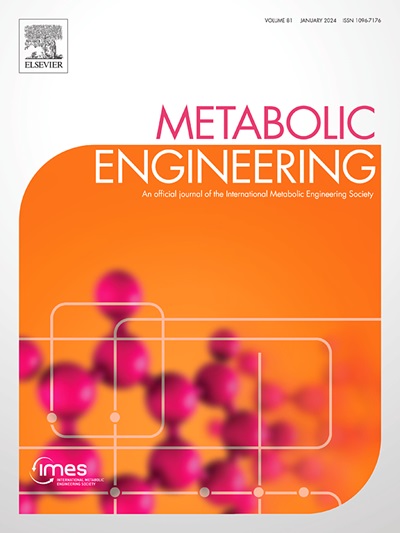利用胞内瓜氨酸提高大肠杆菌精氨酸产量。
IF 6.8
1区 生物学
Q1 BIOTECHNOLOGY & APPLIED MICROBIOLOGY
引用次数: 0
摘要
l -精氨酸是一种高价值氨基酸,广泛应用于食品、饲料、医药等行业。然而,其大规模生物合成仍然受到现有微生物菌株效率低的限制。在本研究中,添加谷氨酸单钠、天冬氨酸单钠和盐酸谷氨酰胺,大肠杆菌- arg4细胞内瓜氨酸积累量分别增加了2.45倍、1.90倍和1.94倍。l -精氨酸滴度相应提高了47.85%、21.18%和10.66%。代谢通量分析和转录组学分析表明,外源性氨供体通过草酰乙酸、α-酮戊二酸和瓜氨酸等关键代谢节点重定向了通量,从而增加了前体利用率,促进了l -精氨酸的生物合成。基于这些发现,我们确定了gdhA、ppc、icd、aspC、glnA、pyrF、gltA和argF等8个关键基因靶点,并进行了途径优化。随后利用启动子工程对其表达进行调控,并引入了来自肠沙门氏菌的外源gdhA和枯草芽孢杆菌的glnA。最终,构建了大肠杆菌- arg10菌株。在1000 L发酵罐中进行工艺优化,大肠杆菌- arg10的滴度为108.33 g/L,产率为0.54 g/g,产率为2.26 g/L/h。这些结果强调了微生物l -精氨酸生产的可扩展和有效的方法。本文章由计算机程序翻译,如有差异,请以英文原文为准。
Improved arginine production in Escherichia coli by harnessing the intracellular citrulline
L-arginine is a high-value amino acid with widely utilized in the food, feed, and pharmaceutical industries. However, its large-scale biosynthesis remains limited by the low efficiency of current microbial strains. In this study, intracellular citrulline accumulation in Escherichia coli-Arg4 was enhanced by 2.45-, 1.90-, and 1.94-fold through supplementation with monosodium glutamate, monosodium aspartate, and glutamine hydrochloride, respectively. Correspondingly, L-arginine titers increased by 47.85 %, 21.18 %, and 10.66 %. Metabolic flux analysis and transcriptomic profiling indicated that exogenous ammonia donors redirected flux through critical metabolic nodes, including oxaloacetate, α-ketoglutarate, and citrulline, thus increasing precursor availability and enhancing L-arginine biosynthesis. Based on these findings, eight key gene targets, such as gdhA, ppc, icd, aspC, glnA, pyrF, gltA, and argF were identified for pathway optimization. Promoter engineering was subsequently employed to modulate their expression, and heterologous gdhA from Salmonella enterica and glnA from Bacillus subtilis were introduced. Consequently, an optimized strain, E. coli-Arg10, was constructed. Following process optimization in a 1000-L fermenter, the titer, yield and productivity of E. coli-Arg10 was achieved 108.33 g/L, 0.54 g/g, and of 2.26 g/L/h, respectively. These results highlight a scalable and efficient approach for microbial L-arginine production.
求助全文
通过发布文献求助,成功后即可免费获取论文全文。
去求助
来源期刊

Metabolic engineering
工程技术-生物工程与应用微生物
CiteScore
15.60
自引率
6.00%
发文量
140
审稿时长
44 days
期刊介绍:
Metabolic Engineering (MBE) is a journal that focuses on publishing original research papers on the directed modulation of metabolic pathways for metabolite overproduction or the enhancement of cellular properties. It welcomes papers that describe the engineering of native pathways and the synthesis of heterologous pathways to convert microorganisms into microbial cell factories. The journal covers experimental, computational, and modeling approaches for understanding metabolic pathways and manipulating them through genetic, media, or environmental means. Effective exploration of metabolic pathways necessitates the use of molecular biology and biochemistry methods, as well as engineering techniques for modeling and data analysis. MBE serves as a platform for interdisciplinary research in fields such as biochemistry, molecular biology, applied microbiology, cellular physiology, cellular nutrition in health and disease, and biochemical engineering. The journal publishes various types of papers, including original research papers and review papers. It is indexed and abstracted in databases such as Scopus, Embase, EMBiology, Current Contents - Life Sciences and Clinical Medicine, Science Citation Index, PubMed/Medline, CAS and Biotechnology Citation Index.
 求助内容:
求助内容: 应助结果提醒方式:
应助结果提醒方式:


